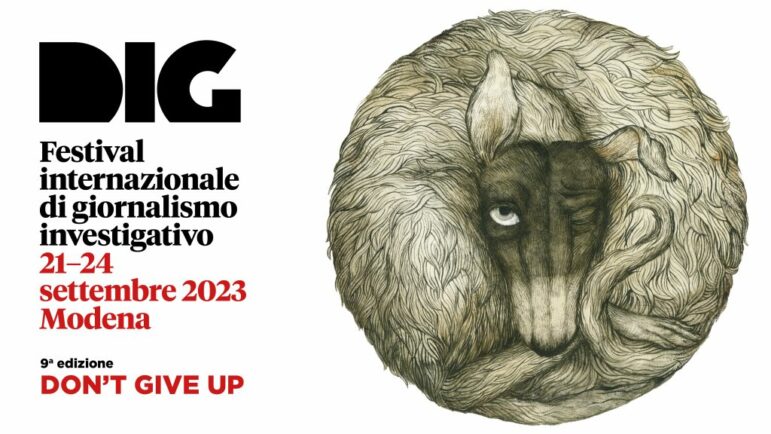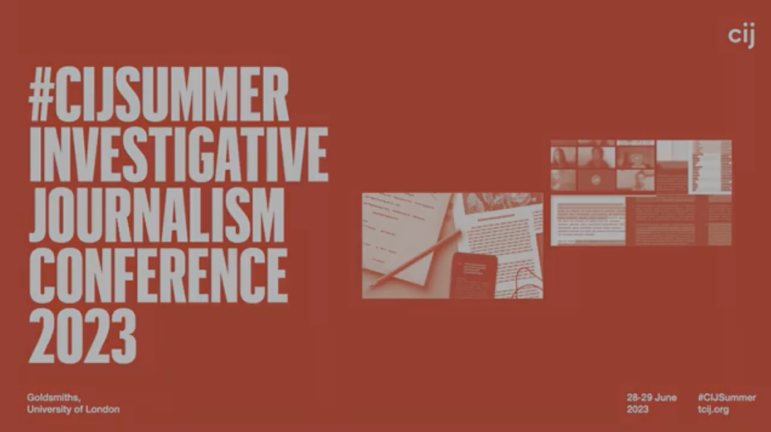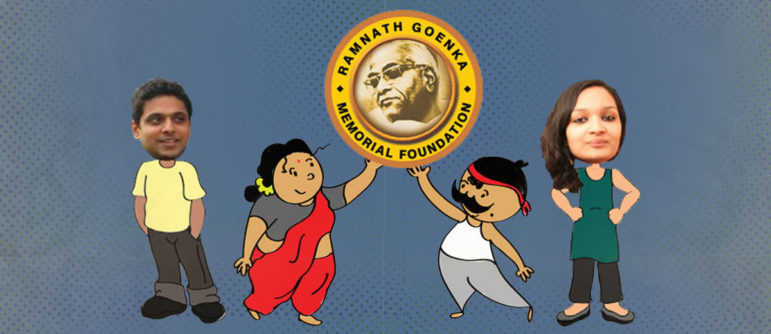

How an Award-Winning Investigation Was Buried in Two Newsrooms
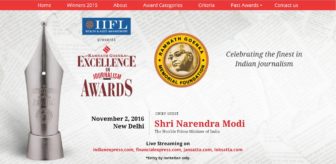 Editor’s Note: Earlier this month the Indian news site Newslaundry won a prestigious Ramnath Goenka Award for a series of stories based on Right to Information (RTI) requests. The information — over 2,000 letters from Indian state-owned enterprises (called public service undertakings, or PSUs) — revealed how political leaders routinely misused as much as US$15 million in public funds by asking PSUs to place media ads in or sponsor irrelevant events for their pet organizations. Here’s the inside story of how the piece almost didn’t come to light, from freelance author Sandeep Pai and Newslaundry’s Manisha Pande.
Editor’s Note: Earlier this month the Indian news site Newslaundry won a prestigious Ramnath Goenka Award for a series of stories based on Right to Information (RTI) requests. The information — over 2,000 letters from Indian state-owned enterprises (called public service undertakings, or PSUs) — revealed how political leaders routinely misused as much as US$15 million in public funds by asking PSUs to place media ads in or sponsor irrelevant events for their pet organizations. Here’s the inside story of how the piece almost didn’t come to light, from freelance author Sandeep Pai and Newslaundry’s Manisha Pande.
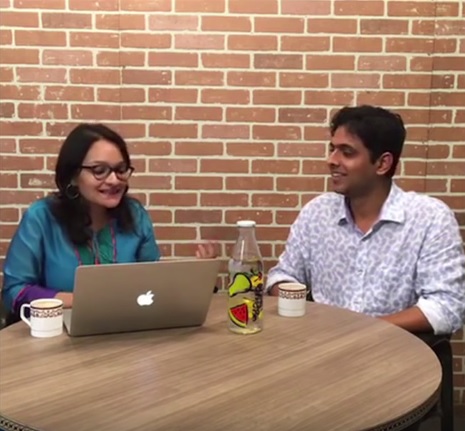
Newslaundry’s Manisha Pande (left) and Sandeep Pai.
It is only apt that Newslaundry’s first Ramnath Goenka Award is for a series of stories that two newsrooms didn’t find worth publishing. It came to us when reporter Sandeep Pai, after chasing the story for nearly a year, called me up and said in a most fatigued tone: “Please find some space to publish it yaar, you’ll see it’s a good story.”
Sandeep had been my colleague during my tenure in DNA, in Delhi. He reached out to me in June 2015 with a stack of Right to Information (RTI) replies from various public sector undertakings (PSUs), and Union ministries. The story was clear – politicians across party lines were using PSUs as their piggy banks to cull favors for organizations with which they were directly or indirectly associated.
You had Members of Parliament (MPs) like Prakash Javdekar asking Rural Electrification Corporation to give ads to an obscure magazine like Brahman Manas (which roughly translates to Brahmin Mindset). There was Maneka Gandhi asking GAIL to fund a three-day event for her non-governmental organisation People for Animals, and PJ Kurien writing to NTPC for assistance of over Rs 70 lakh (about US$115,000) for a boat race in Kerala that was held under his patronage.
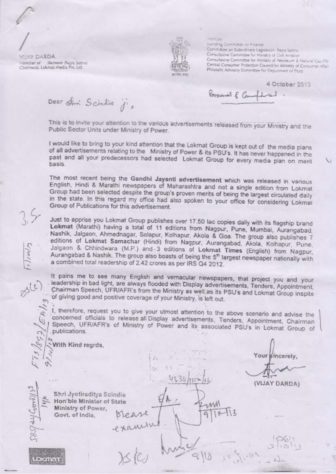 Among these official communications was a gem of a letter written by Congress MP Vijay Darda on October 4, 2013, to the then Minister of State for Power Jyotiraditya Scindia. Darda, who is also Chairman of Lokmat Media Private Limited, was upset with Scindia for not releasing ads to his media group despite its “good and positive coverage” of the power sector. What could be a more telling indictment of the current news model that was so beholden to ads that journalism’s original purpose had been forgotten: to empower, inform and serve public interest above all.
Among these official communications was a gem of a letter written by Congress MP Vijay Darda on October 4, 2013, to the then Minister of State for Power Jyotiraditya Scindia. Darda, who is also Chairman of Lokmat Media Private Limited, was upset with Scindia for not releasing ads to his media group despite its “good and positive coverage” of the power sector. What could be a more telling indictment of the current news model that was so beholden to ads that journalism’s original purpose had been forgotten: to empower, inform and serve public interest above all.
Sandeep’s investigation pointed at a clear conflict of interest and misuse of public money. For us, it was of immense public interest – a story that must be told. But why was it not considered good enough in the two newspapers Sandeep had first pitched it to? This you have to hear from the horse’s mouth.
The Story That No One Would Carry
By Sandeep Pai
I know and have learnt only one form of journalism – anti-establishment journalism. I strongly believe that the role of a journalist is to speak truth to power and hold the powerful accountable.
![]() This idea, however, does not find favor in some media organizations, as I found out when I began working on the RTI series as part of the investigations team of Hindustan Times in Delhi. Like every journalist, I would meet people every day to scout for good stories. Many a times, I would get good stories, but the newspaper would not find it interesting or our armchair editors would say: “So what, why would Neha Chadda from South Delhi be interested in such a story?” Neha Chadda is a Punjabi lady who lives in South Delhi and was at the time considered HT’s archetypal reader. She was fictional, of course, but stories were judged on the basis of whether Neha Chadda would read it.
This idea, however, does not find favor in some media organizations, as I found out when I began working on the RTI series as part of the investigations team of Hindustan Times in Delhi. Like every journalist, I would meet people every day to scout for good stories. Many a times, I would get good stories, but the newspaper would not find it interesting or our armchair editors would say: “So what, why would Neha Chadda from South Delhi be interested in such a story?” Neha Chadda is a Punjabi lady who lives in South Delhi and was at the time considered HT’s archetypal reader. She was fictional, of course, but stories were judged on the basis of whether Neha Chadda would read it.
I would routinely get frustrated at not being allowed to pursue the stories I wanted to – some stories were killed at the idea stage, and some after I wrote them. It was during such times, that I met a source for dinner at Pind Baluchi in Connaught Place in Delhi. As we got chatting, my source told me he was frustrated because his organization, a PSU, was getting several letters from powerful MPs/ministers, seeking funds for random NGOs, unknown magazines and events. My source further said that his organization is forced to release lakhs of rupees on request of different MPs.
I thought this would make a fascinating story. I asked my source whether it is possible for him to leak the documents to me. My source was not sure and instead suggested I file an RTI application.
Without telling my editors, I filed a few RTIs and received initial replies from big PSUs like NTPC that confirmed what my source had told me.
I pitched the idea to my editors at HT. However, the story just didn’t interest them.
 In September 2015, after just a few months and without any job offer, I left HT out of sheer frustration. Soon after, I joined the Special Investigative Team (SIT) of Zee-owned newspaper DNA, in Delhi. I began working on my RTI story again with great encouragement from my editor there. I used the old documents and extended my RTI net and filed appeals with at least 25 PSUs from January 2016 onwards. While I filed at least half of them, I got my activist friends from All India Power Engineers Federation (AIPEF) to file the rest of the RTIs. This was because they knew well how power PSUs function and were more effective at extracting information from them.
In September 2015, after just a few months and without any job offer, I left HT out of sheer frustration. Soon after, I joined the Special Investigative Team (SIT) of Zee-owned newspaper DNA, in Delhi. I began working on my RTI story again with great encouragement from my editor there. I used the old documents and extended my RTI net and filed appeals with at least 25 PSUs from January 2016 onwards. While I filed at least half of them, I got my activist friends from All India Power Engineers Federation (AIPEF) to file the rest of the RTIs. This was because they knew well how power PSUs function and were more effective at extracting information from them.
Meanwhile, I made very good friends with people working in different PSUs. They told me they were frustrated with politicians who are shamelessly writing letters to seek tax payers’ money for their personal gains.
After months of collating RTIs and reading them, the story was good to go in both DNA and ZEE News by April 2016. Despite this and my editor’s best intentions, it got stalled.
 In the meantime, I got a scholarship to study at a prestigious university in Europe. I was so frustrated with the state of journalism in India that leaving Zee was an easy decision. I resigned in May and hoped that these stories would be published before my last day (June 30). When the stories remained buried for over two months, I approached Manisha, who was then senior editor at Newslaundry. It was just two days before my last day at DNA. She had been my colleague and I trusted her. The rest is there for you to read on the Newslaundry website.
In the meantime, I got a scholarship to study at a prestigious university in Europe. I was so frustrated with the state of journalism in India that leaving Zee was an easy decision. I resigned in May and hoped that these stories would be published before my last day (June 30). When the stories remained buried for over two months, I approached Manisha, who was then senior editor at Newslaundry. It was just two days before my last day at DNA. She had been my colleague and I trusted her. The rest is there for you to read on the Newslaundry website.
Sandeep’s account shows how journalism is undermined in Big Media. We’re all ready to go up in arms against obvious censorship and paid news, but what is really sinister is how subtle the process of burying a story can be.
The erosion in the quality of our news pages and prime-time debates is the fallout of a cynical newsroom culture that assumes the reader doesn’t care, or cares only for the base and the crass. This, in some aspects, is driven by the idea of news as a commodity that must remain attractive to a mass audience and hence to advertisers. It is what pays the salaries and keeps bureaus running.
At Newslaundry, our solution to this problem is to follow a completely different business model, one that doesn’t include advertisers. Which is why when we follow stories, it’s because they’re about issues that we believe need to be explored. Not having to worry about advertisers has allowed us immense freedom to pursue a story for the story’s sake, keeping journalism as a priority. It’s meant that we don’t give a damn about who we upset – everyone is game: governments, corporations, media barons, most-watched TV anchors. As long as we have facts (and snark) on our side, we go for it.
Sandeep’s story faced obstacles in Big Media because PSUs and the politicians wielding influence over them can adversely impact the newspapers. Just look at the number of ads that the newspapers had yesterday because it was Kerala, Karnataka, Haryana and Madhya Pradesh’s founding day. We at Newslaundry were free to collaborate with Sandeep because the earnings from those ads are not a concern for us. The story was. The people impacted by the story – that’s you, the reader – were our priority.
Sandeep submitted his work in June. The series was published in August. All of us at Newslaundry – then a small bunch of four – worked to make sure we got every fact right, that we had all sides of the story, and that we present it in a way that doesn’t bore our readers. (Special mention here to Venky, our brilliant tech guy, who stayed up many nights to work on the visualization.)
None of us cared about things like “hits” and all of us believed the story should be out. It made an impact – some PSUs took note of the series and issued internal circulars to not release unnecessary funds at the behest of MPs. The numbers weren’t bad either – the story got reasonable readership (we hope among the likes of Neha Chadda too). And now there is the Ramnath Goenka Award for Investigative Journalism. Apart from clubbing Sandeep and me in the same company as journalistic greats like Zee News’s Sudhir Chaudhury, this award is a validation of what Newslaundry believes and acknowledgement from our peers.
The recognition, of course, is not just for Sandeep and me, but for the entire Newslaundry family: all our readers, supporters and especially our subscribers. You keep us going. Quite literally. May your tribe grow and may we work harder to make it all worth your while.
 This story was first published on Newslaundry.com, and is reprinted with permission. Newslaundry is an independent news media and news critique website. Here’s a link to the series that won the award. Manisha Pande is a journalist with Newslaundry. She previously wrote for DNA India and Business Standard. Sandeep Pai is a freelance journalist who has worked with the Hindustan Times & DNA newspaper.
This story was first published on Newslaundry.com, and is reprinted with permission. Newslaundry is an independent news media and news critique website. Here’s a link to the series that won the award. Manisha Pande is a journalist with Newslaundry. She previously wrote for DNA India and Business Standard. Sandeep Pai is a freelance journalist who has worked with the Hindustan Times & DNA newspaper.





